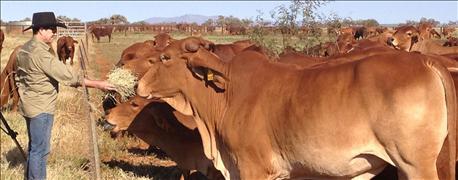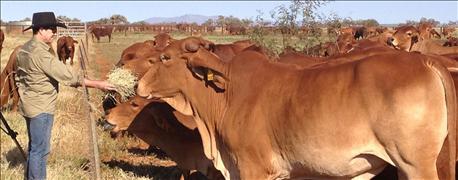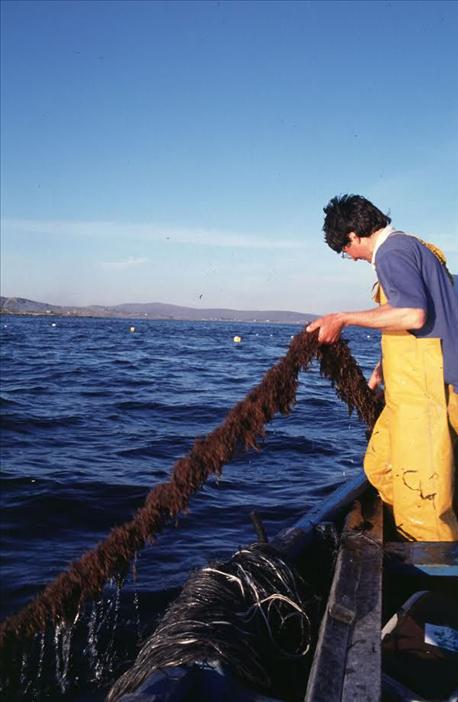December 8, 2016

Australians may have found the silver bullet to methane emissions from livestock — one source of greenhouse gas emissions causing global warming.
A seaweed widespread in the waters around the world, researchers say, reduces methane production by more than 99% in the laboratory, and it is effective making up just under 2% of livestock fodder.
Canadian researchers including Rob Kinley, then of Dalhousie University in Halifax, started the ball rolling with a global search for a potent seaweed after they found Prince Edward Island cattle that were eating seaweed reduced their methane production by about 20%.
 CATTLE NEXT: Researcher Rob Kinley has been studying methane production in live sheep fed seaweed. He has set his sights on incorporating it into cattle diets. Here, he’s working in Australia’s Northern Territory. (Photos: CSIRO)
CATTLE NEXT: Researcher Rob Kinley has been studying methane production in live sheep fed seaweed. He has set his sights on incorporating it into cattle diets. Here, he’s working in Australia’s Northern Territory. (Photos: CSIRO)
Kinley, who has since moved to Australia’s Commonwealth Scientific and Industrial Research Organisation, worked with other CSIRO scientists and marine algae specialists at James Cook University in Queensland to test 20 seaweed species with a resulting reduction in methane ranging from zero to 50%.
Artificial rumens
The researchers used artificial rumens for their testing. “You create the conditions you would see in a cow's stomach in a bottle,” says Rocky De Nys, an aquaculture professor at James Cook University. “You do that by collecting a little bit from the cow's stomach to start with.
“They get a little bit of material from inside the rumen that has all those microbes, and then they add them to different grasses or substrates, and then you add a little bit of seaweed to that. As they ferment, in the same way as inside a cow, the gas is created and it creates pressure.”
 SEAWEED PRODUCTION: Asparagopsis seaweed is grown on ropes in Ireland.
SEAWEED PRODUCTION: Asparagopsis seaweed is grown on ropes in Ireland.
De Nys says by measuring and sampling the pressure of the gas, the researchers are able to determine the volume of methane gas.Initially, all the seaweeds were tested at 20% in the fodder, a level too high for the animals’ health, as well as not being economically feasible.But then came the breakthrough.
Michael Battaglia, CSIRO’s Agricultural Mitigation and Adaptation group leader, writes in an article for The Conversation website that a seaweed collected from north Queensland’s waters, called Asparagopsis taxiformis, produces a compound called bromoform, which prevents methane production by reacting with vitamin B12. This disrupts the enzymes used by gut microbes that produce methane gas as waste during digestion.
2 strains of seaweed
The seaweed is highly invasive, and Kinley tells Michigan Farmer in a telephone interview there are two strains. One thrives in water temperatures of 63 to 72 degrees F and the other in 68 to 79 degrees, and they are distributed in variable densities around the world. “You won’t find it at the equator, because the water stays too warm,” he says.
Globally, 1.3 billion people depend on livestock for their livelihood, and the cows and sheep that provide this also produce 3.1 gigatons of methane, a gas with a far higher global warming potential than carbon dioxide, according to CSIRO. Contrary to some thinking, 90% of livestock methane comes from belching.
The CSIRO and James Cook University research is supported by Meat and Livestock Australia and the Australian government. The work includes trials to see if the effect measured in the lab is repeated with live animal experiments.
De Nys tells the Australian Broadcasting Corp. that sheep trials using the dried Asparagopsis seaweed showed a significant cut in methane emissions. “We have results already with whole sheep,” he says. “We know that if a low-quality Asparagopsis is fed to sheep at 2% of their diet, they produce between 50% and 70% less methane over a 72-day period continuously, so there is already a well-established precedent. We had an inkling that we would get some success from this species, but the scale or the amount of success and reduction we saw was very surprising.”
He says the seaweed trials with live animals will continue at the CSIRO Lansdown facility near Townsville in Queensland until mid-2017 to analyze the effects seaweed could have on cattle production.
“Using a good-quality version allows for greater reductions with even less seaweed, so at 1.5% of the fodder we can remove more than 85% of methane,” Kinley says.
Access to seaweed
Kinley says while the research is promising, he is concerned about access to seaweed. “That is the No. 1 barrier, getting enough seaweed to feed to millions of cows,” he says. “Wild harvesting isn't going to do it, because it's far too expensive, and the resources aren't enough, so we need to get partners on board who can produce the seaweed in a cultivation process.”
Battaglia says producing enough Asparagopsis to feed 10% of the almost 1 million feedlot and 1.5 million dairy cattle in Australia would require about 300,000 tons a year. Taking the product global would require millions of tons.
Typical seaweed production would come in at 12 to 20 tons of dry matter an acre. Supplying just 10% of the Australian livestock industry, Battaglia says, would require at least 14,800 acres of seaweed farms.
Kinley says there’s a way to go before the seaweed reaches the commercial market. “We have to find funding for more research,” he says. “Then we have to find funding to create the industry and its infrastructure.”
Despite this, Kinley says with the livestock industry under fire over its methane emissions and for a planet under pressure from greenhouse gas emissions, the findings thus far are an important breakthrough. “It’s really great news."
Harman writes from Brighton.
About the Author(s)
You May Also Like




